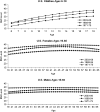Recent dynamics suggest selected countries catching up to US obesity
- PMID: 19906804
- PMCID: PMC2793114
- DOI: 10.3945/ajcn.2009.28473C
Recent dynamics suggest selected countries catching up to US obesity
Abstract
Background: The United States has been the country with the highest body mass indexes (BMIs; in kg/m(2)) at higher centiles, but research that compares the United States with other nations is lacking.
Objective: To present a picture of global obesity and examine the shifts in BMI in children, I examined BMI data for men and women at the upper ends of the BMI distributions in Australia, China, the United Kingdom, and the United States.
Design: As representative data, I used directly measured weight and height for children aged 6-18 y and for men and women aged > or =19 y. Quantile regression analysis with BMI was used to determine the outcome, and the coefficients of age, age squared, and age cubed represented the explanatory variables plotted to determine mean BMI at the 95th centile for each age group. Overweight and obesity measures across all selected countries, with the use of nationally representative surveys and the 95th centile mean BMI, were determined.
Results: Among women, much larger increases were found in mean BMI at the 95th percentile in Australia (+5.7 BMI units) and the United Kingdom (+3.7 BMI units) than in the United States (+2.7 BMI units) in one-half the time. In contrast, among children, younger Chinese children experienced the largest increase. For example, the mean BMI at the 95th centile for 6-y-old Chinese children is 24.8 (a 5.0 increase), which is 2.6 BMI units more than the BMI at the 95th centile for children in the United States.
Conclusions: Among children, BMIs for US children at the 95th centile are below those in China, whereas among women, Australian and UK women are rapidly approaching BMIs found in US women.
Figures




References
-
- Popkin BM. The world is fat—the fads, trends, policies, and products that are fattening the human race. New York, NY: Avery-Penguin Group, 2008
-
- World Health Organization Diet, nutrition, and the prevention of chronic diseases. WHO Technical Report Series. Geneva, Switzerland: World Health Organization, 2003 - PubMed
-
- Cowie CC, Rust KF, Byrd-Holt DD, et al. Prevalence of diabetes and impaired fasting glucose in adults in the U.S. population: National Health and Nutrition Examination Survey 1999–2002. Diabetes Care 2006;29:1263–8 - PubMed
-
- Mendez MA, Monteiro CA, Popkin BM. Overweight exceeds underweight among women in most developing countries. Am J Clin Nutr 2005;81:714–21 - PubMed
-
- Popkin BM. Global nutrition dynamics: the world is shifting rapidly toward a diet linked with noncommunicable diseases. Am J Clin Nutr 2006;84:289–98 - PubMed
Publication types
MeSH terms
Grants and funding
LinkOut - more resources
Full Text Sources
Medical
Research Materials

